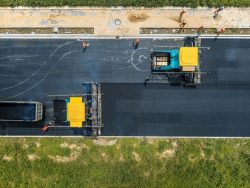The Science and Process Behind a Smooth, Durable Pavement

1. The Foundation
One of the key elements in constructing a long-lasting pavement is a solid foundation. The foundation provides support and stability to the pavement structure. Before any asphalt is laid, the existing soil is carefully evaluated and prepared. This may involve excavating and removing any weak or unstable soil, and replacing it with a stable base material, such as crushed stone or gravel. The base material is then thoroughly compacted to create a strong foundation for the pavement.
2. Understanding Asphalt Composition
Asphalt, the main component of pavement, is a mixture of aggregates (such as crushed stone and sand) and a binding agent called bitumen. The proportions of these materials and the quality of the bitumen play a crucial role in determining the durability and performance of the pavement. Scientifically, the mix design of asphalt considers factors like aggregate gradation, asphalt content, and the use of additives like polymers or fibers to enhance its properties. A well-designed asphalt mixture will have sufficient stability, flexibility, and resistance to cracking and rutting.
3. The Compaction Process
Proper compaction is essential for achieving a smooth, durable pavement. When hot asphalt is laid, it is compacted using heavy machinery, such as rollers, to squeeze out any air voids and achieve a denser structure. The compaction process must be performed at the right temperature and with the proper number of passes to ensure uniformity and optimal density. Scientific testing methods, like the use of nuclear gauges or vibratory compactors, help ensure that the asphalt is compacted to the desired level.
4. Controlling Temperature
Temperature control is critical during the construction of a pavement. The temperature of the hot asphalt mix must be carefully monitored during transportation and placement to ensure workability and proper compaction. If the asphalt is too cold, it may not compact properly, leading to poor bond between layers and reduced durability. On the other hand, if the asphalt is too hot, it can lead to rutting and distortion. Scientific instruments, such as infrared thermometers, are used to measure and control the temperature of the asphalt throughout the construction process.
5. Addressing Drainage Issues
Proper drainage is vital for the longevity of a pavement. Accumulated water can accelerate pavement deterioration, leading to cracks, potholes, and even structural failure. Scientific principles are employed to design effective drainage systems, which may include slopes, curbs, gutters, and underground pipes to direct water away from the pavement surface. Additionally, the asphalt mix itself can be modified with special additives to improve its resistance to moisture damage, further enhancing the pavement’s durability.
6. Quality Control and Testing
A smooth, durable pavement requires strict quality control and regular testing. Throughout the construction process, samples of the asphalt mixture are taken and tested in a laboratory to ensure compliance with design specifications. Various tests, such as compaction tests, asphalt content analysis, and strength tests, are conducted to verify the quality and performance of the pavement. These scientific tests provide valuable data that help in fine-tuning the mix design and construction methods for optimum results.
7. Ongoing Maintenance and Rehabilitation
Even the most well-constructed pavement requires ongoing maintenance to keep it in top condition. Regular inspections, crack sealing, patching, and periodic resurfacing are some of the maintenance activities that contribute to the longevity of the pavement. Scientific research and advancements continue to improve pavement materials and maintenance techniques, enabling engineers to develop sustainable and cost-effective solutions for preserving and rehabilitating existing pavements.
Summary
Constructing a smooth, durable pavement involves a complex process that combines scientific principles with practical engineering. From preparing a solid foundation to controlling temperatures and conducting quality tests, each step plays a crucial role in achieving a strong and long-lasting pavement. By incorporating the latest scientific advancements and best practices, engineers can continue to enhance the performance and lifespan of our road infrastructure, providing us with safe and reliable transportation routes.
Need a Paving Contractor in Damascus, MD?
Established in 2014, Maryland Asphalt LLC has been providing high-quality asphalt and paving services to the areas of Montgomery and Frederick Counties and the surrounding areas. Family owned and operated, we offer quality services at competitive prices. We specialize in commercial and residential asphalt paving and our asphalt services including parking lot maintenance, parking lot repair, commercial driveways, residential driveways, public and private roads, resurfacing, seal-coating and more! Don’t settle for less. The cost of doing it over is more than the cost of doing it right the first time. If you need an expert paver you can trust, call us today.
Categorised in: Asphalt
